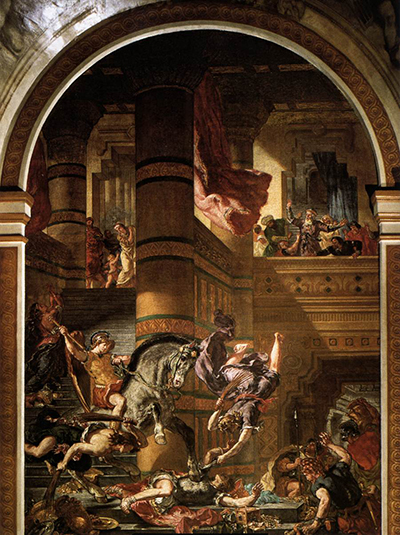Heliodorus Driven from the Temple offers another example of how the Italian Renaissance would inspire and lead artist Delacroix at various points in his career. He took ideas from a variety of sources, including Islamic culture, English literature and also the past paintings of the old masters.
One can immediately determine a Baroque style within this artwork, with a flurry of activity which will remind some of the work of Rubens, such as Hippopotamus and Crocodile Hunt, Massacre of the Innocents and Beheading of St John the Baptist. Specifically, the angels which float around the scene remind us of some of his own pieces. Delacroix is able to display several of his own qualities within this version, with his knowledge of the anatomy of horses, as well as great qualities in depicting fashion and drapery. The background features some dominant pillars and other architectural details that were also within the skillset of this talented and hard working painter. He would have produced a large number of study drawings before completing this piece. Further evidence of the earlier stages of preparation can be found in the Metropolitan Museum of Art, where several of said sketches can be found. He seemed to focus particularly on the horse and knight within those drawings, and used a combination of pen, iron gall ink and graphite to perfect the outlines of their respective figures.
Heliodorus enter the Temple of Jerusalem in order to claim its treasures for himself. This tale comes from the Second Book of Maccabees and he himself was the equivalent of the prime minister of the time, in Syria second century BC. Although the scene is taken from the piece found in the Vatican, the style used by Delacroix is actually quite different. He draws on inspiration from the likes of Rubens, as mentioned, but also the Venetian greats such as Veronese and also Tintoretto. A browse of their work will immediately underline this connection, particularly in the way in which this painting features brighter tones and also some incredibly detailed architectural interiors. He was a master of innovation, whilst drawing in ideas from other artists, which made an extraordinary combination which touched on a wide number of genres within his career.
Raphael's version of this theme was placed in the Stanza di Eliodoro, as part of the Raphael Rooms within the Apostolic Palace in the Vatican. His work here, alongside the likes of Michelangelo's Last Judgement and Creation of Adam, make this probably the finest series of installed frescoes in the world and has enabled this location to be amongst the most visited Italian venues of all. Infact, it is so popular that numbers consistently have to be restricted in order to allow those that do visit to enjoy and appreciate their visit, as well as also protecting these critical artworks for future generations. It is unsurprising that such brilliance would continue to inspire artists such as Eugene Delacroix many centuries later, and continue to do so today. Raphael's work on the Heliodorus Driven from the Temple fresco is believed to have been carried out between 1511 and 1513.




